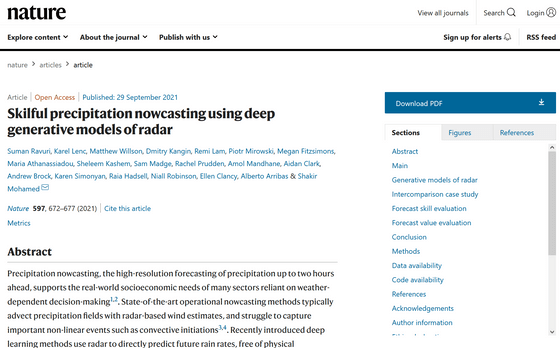Google-related company DeepMind greatly improves the accuracy of weather forecasts up to 90 minutes ahead, accuracy recognized by weather forecasters

Skilful precipitation nowcasting using deep generative models of radar | Nature
https://www.nature.com/articles/s41586-021-03854-z

Nowcasting the Next Hour of Rain | DeepMind
In modern weather prediction, a method called 'numerical weather prediction' is used to predict the future weather by numerically calculating the movement of fluid in the atmosphere. Numerical weather prediction is good for predicting the weather from 6 hours ahead to about 2 weeks later, but it is said to be less accurate when predicting the weather within 2 hours.
DeepMind co-leader Suman Ravuri and colleagues have built a deep generative model 'DGMR' to improve the accuracy of so-called 'short-term forecasts' within two hours. Designed to use an algorithm similar to the Generative Adversarial Network (GAN) used for image generation to learn the movement of rain clouds captured by the weather radar and predict and generate the movement of rain clouds 5 to 90 minutes ahead. bottom.
In order to verify the accuracy of the prediction results generated by DGMR, Ravuri et al. Prepared two existing precipitation probability prediction models and asked 56 weather forecasters to evaluate the accuracy, hiding their names. As a result, DGMR was rated as 'most accurate and useful' in 89% of cases. Of the following, the upper left is the observed actual cloud movement, and the upper right is the DGMR. Unlike PySTEPS (bottom left), an advection approach where precipitation intensity is often too high, and deep learning UNet (bottom right), where simulation results can be blurred, DGMR balances the intensity and range of precipitation probabilities. , You can see that it is close to the actual observation record.

The development team said, 'We consider this an exciting area of research, and our research will serve as the basis for new research, facilitating the integration of machine learning and environmental science, and making better decisions in weather forecasting. I hope it will be supported. '

Related Posts:







